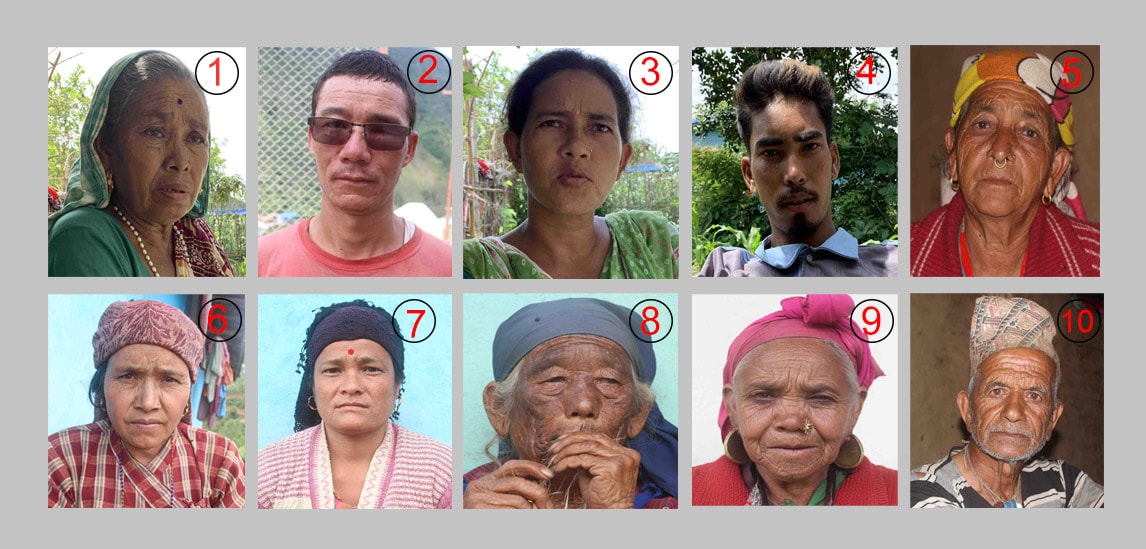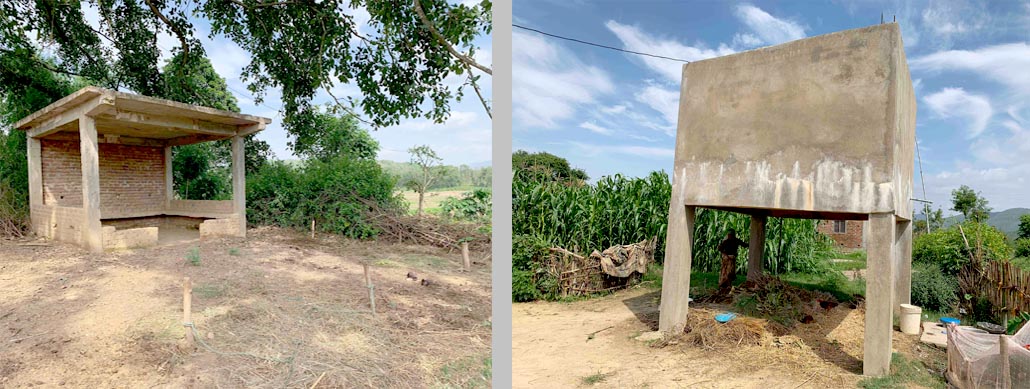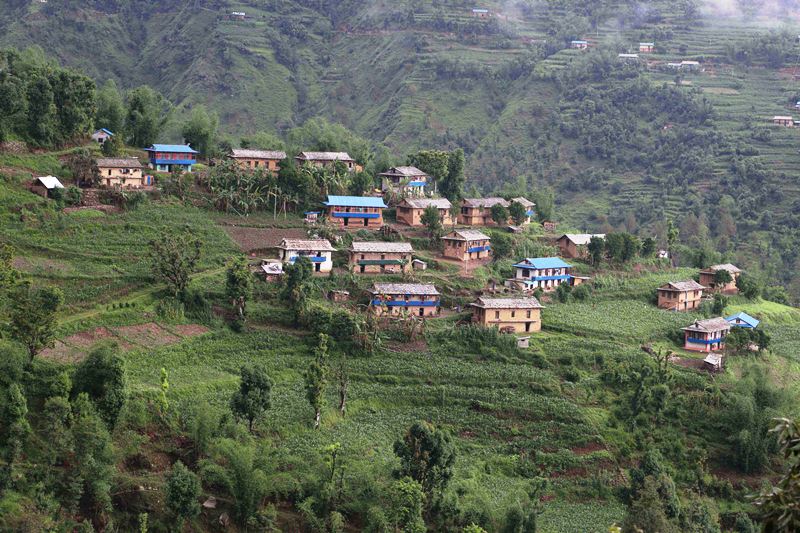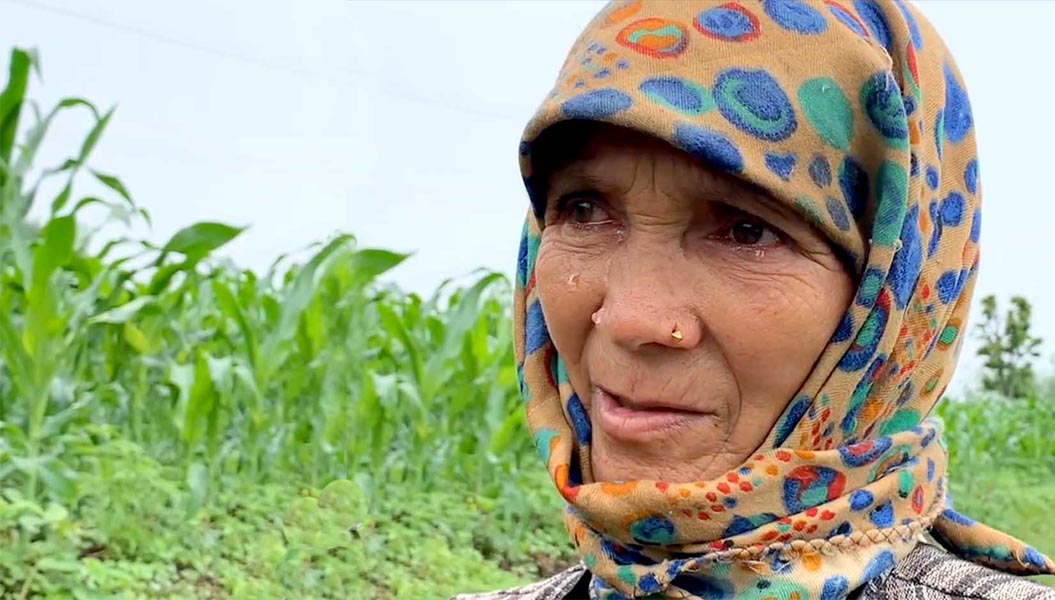Local Maoist leaders embezzled Rs 200 million allocated to build four model villages in the districts of Dang, Rukum, Rolpa and Salyan for those killed, injured and displaced persons during a decade long deadly Maoist insurgency. One and half decades after misuse of budget some victims have spoken up.
Durga Lal KC: Center for Investigative Journalism-Nepal
The Rapti region was a bastion of former Maoists and the government had mobilized all available security forces there to quell armed activities of the rebel party during a decade long Maoist insurgency. This resulted in several crossfires–ranging from minor to deadly attacks–in remote villages where nearly 17000 people were killed in total. Several villagers who had never participated in war or people with zero interest in politics were also injured, their houses were burnt down and many disables are living a miserable life.
As a peace deal was signed between the government and the Maoists in November 2006 several programs were designed aimed at providing relief and compensation for conflict victims. Building a ‘model village’ in the worst conflict affected villages was one among many other programs. Under this program Peace and Reconstruction Ministry selected four villages–Kauwaghari of Dang, Guranse of Salyan, Khara of Rukum and Jelbang of Rolpa–and budget was also allotted accordingly.
But nothing has been changed in those villages even after one and half decades elapsed since the deal. And currently there is no existence of some activities done there in the name of ‘model village’. Some works were carried out just for formality. After going through government documents and interviewing locals one can easily understand what kind of monopoly was practiced in spending budget for conflict victims.
1 million for Kauwaghari
On August 1, 2002, 12 locals from Kauwaghari of Dangisharan Rural Municipality, Dang, were shot dead. As briefed by locals the Army deployed to guard telephone towers, assembled locals collecting firewood in the jungle, asked them form a queue and opened fire at them. Among the deceased, seven brothers were from a single family. The ministry released NRs 10.7 million to develop this backward remote area as a model village. After going through the Road Infrastructures Development Office, Dang, and analyzing the budget it feels like “is that possible?”. Documents show the budget was used to gravel a two-kilometer road, lay pipe for irrigation, build water tanks, deep-boring wells and resting places.

1. Bijuli Sarki from Kauwadhari, who lost 3 sons during the maosit insurgeny. 2. Prithvi Prasad Subba from Rolpa, Jailbang, who lost one of his during a clash with the army and maosits in the village. 3. Laxmi Nepali, from Dang, Kauwadhari, who lost her husband. 4. Jagatram Nepal from Dang, Kauwadhari, who lost his father. 5. Rati Bali from Rukum, Kharaki who lost her husband and son during the insurgency. 6.Nandakala Kunwar, from Salyan, Gurans. Her eye was maimed during the maoist conflict. 7. Lalita Kunwar Yogi from Salyan Guranse whose father-in-law was shot dead in front of her. 8. Farki Buda from Rolpa Jailbang, who lost her only son. 9. Bisha Kami from Rolpa Jailbang who lost her 4-year-old daughter during gun firing at the village. 10. Parshiram Khatri from Rukum Khara, who lost her son during the insurgency.
In reality, there is no existence of deep bore fixed spending hundreds of thousands of rupees. It’s really difficult to trace irrigation infrastructures built at the cost of Rs 1 million. Water tank constructed at cost Rs 1 million is in existence but is left without water. Rs 1 million was spent to build a resting place, which is now used to keep oxen. Likewise, Rs 5 million was spent for gravelling a section of road, which has now turned as grassland.
Even as 18 years have elapsed since the promise of model village no visible change is in villages. “They promised to develop this village like a heaven,” said Bijuli Sarki, 63, who lost three of her sons in war, adding “Our sons died of billet. But leaders embezzled the money released in the name of those killed by bullets. Village looks like the same old place.”
Sita Sarki, 60, whose husband was also killed in the army’s firing said she had never seen money released for model villages. “We need to walk for hours to fetch water. There is no school in the nearby area, no health post. How can this be like a model village?” questioned Sita.
Hoping to get drinking water, Ghani Nepali had donated her land to build a water tank. It’s been five years since the water tank was erected but in vain. Locals have to walk one hour to collect water. “I had donated land hoping all will get drinking water easily,” said Ghani, 68, adding “They pocketed the money without doing any work.”
So, how was the budget spent? It’s really interesting. Mohan BK, a dominant Maoist leader from Kachila of Tulsipur Sub-Metropolitan City, was named secretary of local users’ committee whereas another Maoist leader Netra Sarki was named chairperson.
Both of them were not conflict victims. They named other conflict victims as committee members and mobilized the fund as per their wish. As the budget allocated in the fiscal year of 2009-2010 was spent, locals protested the involvement of outsiders and non-conflict victims. Following the protest Mohan bought four kaththas of land in Kauwaghari and named local conflict victim Laxmi Nepali as treasurer of the committee. Laxmi did nothing other than putting her signatures in papers for a couple of times.
“I have no idea about expenses although I’m a treasurer. Later, I came to know that my fake signatures were also used to draw money from the bank,” she said.
Laxmi’s husband, Ramesh, was also killed in the army’s action. Her son Nabin was born 14 days after Ramesh was killed. Nabin is now studying in grade 10 and her daughter is in eleventh grade. “It was assured that there will be no more hardship in the model village,” said Laxmi, who worked hard to raise her children, “Nothing has been done. Instead, we are enduring more problems.”
After victims hardened their positions regarding participation of conflict victims Jagat Ram Nepali was named chairperson of the group six years after the model village project was started. Jagat Ram’s father, Ram Prasad, was also killed in Kauwaghari. A total of Nrs 3 million was released after Jagat Ram took charge of the group. Some projects such as water tank, causeway, resting place and road were constructed under his leadership.
The then users’ committee chief Netra has now reached Malayasia seeking job opportunities. Mohan has now constructed a new house in Kachila. Mohan claims he got leadership of the user’s group as he was from Maoist party. He denied his involvement in misuse of funds.
“When Congress was in government they obstructed us from working. Whoever leads the work he faces accusation,” said Mohan.
When work progressed and details of expenses incurred to build a model village in Kauwaghari were sought, officials at the District Coordination Committee refused to comment saying ‘that’s an old issue’.
Sabitra Pun, an official at the committee, asked non-gazetted officer Yam Kumar Basnet to produce the documents. Three days later Basnet replied, “Nothing was found. Please consult with the Office of District Technical.”The Office now falls under the Road Infrastructure Development Office of Province 5. Basudev Bhandari, an officer of the new office said he was unable to find documents saying he and his officers are totally new in the office. But some documents were recovered with the help of bureaucrats, who had earlier worked at the office.
NRs 30 million in Khara
On February 22, 2000, Nepal Police set fire to 68 houses of Khuncheri, Saunepani, Pokhari, Kalimati, Kural and Hampal, Daya and Jyamire villages of Khara Village Development Committee, Rukum. Police gunned down 15 civilians. Angered by the death of their fellow policeman Gopal KC in Maoist attack while patrolling around the village, police had burnt down villages.

Waiting place and water tank made in a model settlement in Kauwadhari.
To take revenge Maoists attacked Khara army barracks twice in July 2002 and April 2005 in which Maoist faced a huge loss. During the insurgency 28 persons were killed by the state whereas Maoists killed a person in Khara.
Among those killed by the state 22 were civilians and six were party cadres. Among those killed by the police Tek Bahadur Oli, 52, was Nepali Congress leader and chief of the then Khara VDC. Tek Bahadur’s eldest son, Bhim Bahadur, was also killed in war and another son, Tantabir was seriously injured in police firing but survived.
Rati’s husband, Tribhan, and two sons were snatched away from her home and later shot after taking them up the hill. Rati was one to witness live murder of husband and sons. She says five people including his husband, two sons and brother-in-law shot dead shortly after asking them to queue up. Rati was successful in saving her son’s blood-soaked son by covering him with a blanket.
After the peace deal the government introduced a model village program. Under the program NRs 34800000 was allocated to build model villages. But victims like Rait haven’t not experienced any visible progress in her village.
Local leaders didn’t want to include victims in users’ committee when the government released money in 2009. “When I asked them, aren’t you really incorporating victims in the committee? Initially, they were reluctant. But later named us as members,” said Rati, “But they didn’t invite not even a single meeting.”
Krishna Oli, 60, of Kural had witnessed her son, Lal Bahadur, shot dead by police. Police brutally thrashed her after killing her 21-year old son.
Krishna has to arrange NRs 4000 monthly for regular medication. Her husband, Nar Bahadur, begins to sob whenever he remembers past brutality. Asked what’s going on these days Nar Bahadur says, “Leaders amassed properties, there’s nothing on our plate.” Experience of Kirti Bahadur Oli, 36, tells so much about how local leaders misused the budget allocated for building Khara as a model village. He complains of being deprived of getting money as promised even as his wife worked for a road project.
“As they promised money for those participating in road construction projects. My wife worked there carrying a baby,” said Kirti Bahadur adding, “It’s quite frustrating not to ask wages. They deceived us.”
Elected head of consumer’s group in 2009 Birbhan Oli worked for a year. Binod KC replaced Oli and led the committee from 2010 to 2013. Appointed as committee head in 2013 Ram Bahadur Khadka remained in position until 2015. Only local Maoist leaders led the committee.
As locals started to construct Jhulneta-Khumcheri road, a rival group wanted to build Simrutu-Lait road. Engulfed in protest, locals started to construct the Simrutu-Lait road section as well instead of continuing the road meant for conflict victims. With this, conflict victims from Kural and Pokhari protested after a budget allocated for them was spent for another project.
In an effort to settle the row they divided the budget for both the road projects. Khadka continued to work as chief of Jhulneta-Khumcheri road construction users’ committee whereas Bir Bahadur Oli, Khadka BK and Ganesh KC were named chief of a users’ committee formed to build the Simrutu-Lait Road project. Since the budget was inadequate for both the project budget it didn’t work at all.
Heads of committees mobilized the budget on their own. Even as Rs 34.8 million was allocated to develop war-devastated Khara Village, locals were never informed about it nor any public transparency tools such as public hearing, public audit and interactions were practiced.
Interestingly, even heads of consumers’ groups are unaware about how budget was spent for road projects. “Many people were in the committee so I have no complete information,” said Birbhan Oli, first head of consumers’ group, “I can tell you only about construction of five-kilometer road. Binod KC knows all about it.”
Like Oli Khadka said he also has no complete information about the budget. “Committee’s leadership was fast changing. I had also handed over leadership so I don’t know about the budget and how much they spent,” said Khadka.
Khadka, who worked as last chairperson of the user’s group, also has no complete expenditure details of road projects.
Most victims were from three and five wards of the then Khara VDC. And the budget was allocated for those wards. “Our houses burnt down. We were left homeless. But others embezzled the money allocated for us,” said Rim Bahadur Khatri.
Details compiled by Rukum (West) District Coordination Committee shows track of a 13-kilometer Jhulneta-Khumcheri and another Simrutu-Lait (7km) have been opened. Budget was used to build seven four-room schools. As per government records toilets have been built for 28 households, playgrounds of two schools have been expanded and completed two drinking water projects. But locals’ labor contribution has worked more than the government budget.
Local representatives say they are now suffering due to the model village. “When we ask for a development budget they say millions have already been spent for model villages and ask why we need an additional budget. We are suffering,” said Chandra Bahadur Khadka, chief of ward-4 of Tribeni Rural Municipality.
Shanti Raj Prasai, an official at the district coordination committee said he was unaware about the model village project saying he is the new face in office.
Irregularities in Guranse
When Maoists attacked army patrolling around Guranse Village of Salyan in the evening of June 12, 2002 they fought a deadly war until afternoon of next day. Of total 62 houses burnt down 35 were completely reduced to ashes.

Khara village of Rukum West
For locals it took more than a year to rebuild those houses. Locals still fear to share horrific incident to outsiders. “All houses of this village were burnt down. Where to go for help? Who will help us even if we plead for help. It’s hard to tell,” said Nandakala Kunwar Yogi. Two shrapnel were pierced just above her eye. Even as doctors successfully remove one shrapnel she’s still living with another one. “Because of shrapnel I often faint.”
Nineteen persons of this village were killed in war.
Like other war affected villages, the government allocated Nrs 29 million to develop Guranse as a model village after Maoists joined the peace process in 2007. But the budget was spent haphazardly. When asked about expenditure details no official information was provided. Locals say the entire budget was spent as instructed by the Chitra Bahadur KC, Maoist leader and the then head of consumers’ group formed to mobilize the fund.
Of the total Nrs 4200,000 total budget allocated in the fiscal year 2008-2009 Nrs 3500,000 was spent to build Lamachaur-Manimare Road, Rs 700,000 to build a four-room school of Janata Higher Secondary School. In the fiscal year of 2009-2010 the government released Rs 10 million. Of the total budget, Rs 7.9 million was used to electrify the village and remaining Rs 210,000 for road projects.
Of the total Rs 6.8 million allocated in the fiscal year of 2010-2011 Rs 250,000 was allocated to expand electricity in Dahagaun, Dahakhola, Damachaur and Sidre. Rs 4.3 million was spent for drinking water and sanitation. The government allocated Rs 4 million in the fiscal year 2012-2013. Rs 2 million was spent for agricultural development, Nrs 1 million for plant development and the remaining budget was used to build Martyrs Park. It was stated that saplings of kiwi, apple and walnuts were planted under an agricultural development program. But these plants now don’t exist anywhere in the village. Nrs 4 million was spent to construct a community building.
Locals of Guranse are now annoyed with the title of model village. “Vehicles don’t play on the road. Electricity is not available. How can this village be like a model village,” said Pokhraj Yogi, one of the conflict victims.
Another victim Nim Bahadur Yogi is miffed with the politicians. “Leaders used to promise employment for victims, offer training and then make them self-reliant. These days, they say the entire budget was spent for road and electricity.”
Rs 120 million in Jelbang
Jelbang is the worst affected VDC in the war. Altogether 73 persons–63 from state forces and 10 from Maoists–were killed during the war. To build this village as a model village the ministry allocated Rs 42.8 million whereas the total budget allocated for this village was 120 million. Of the total budget, Rs 47.641 million was spent for road construction, Rs 436,900 was spent for electrifying village and remaining budget was allocated for other development works.

Krishna Bali from Khara, who lost her son during the insurgency and was tortured by the police.
Maoist leader Tika Bahadur Budha led the consumers’ committee formed to mobilize the fund. Budha now thinks he couldn’t work as expected. “When budget was released CDO instructed us not to spent the budget for road, electricity and drinking water projects but to focus on other activities that directly helps conflict victims saying offices concerned will work on development project,” said Budha, who is now village chief of Sunchhahari Rural Municity-8 adding, “But party leader prioritized to work for road and electricity. Money was spent as they suggested.”
Apart from the government released budget for model village British Gorkha Welfare had completed 16 drinking water projects worth Rs 25.221 million from fiscal year 2008-2009 to 2017-2018.
Almost every household of Jelbang, which consists 73% Magar and 27% Dalit communities, are conflict victims. For example, Police killed only son of Farki Budha, 76, in February 1998. Her son, Bhuwan was 23 when he was killed. She is alone after her husband died last year. Furki sleeps with an empty stomach when she fails to cook food on her own.
None of government offices in Rolpa can provide details of expenditure details of projects under model village citing frequent transfer of government officials and non-existence of previous offices.
Victims express anger against misuse of funds allocated for developing this war destroyed village as a model village. “They weighed war, killed the people. They just worked for their own benefit but did nothing for us,” said Birsha Kami, a local of Jelbang.



